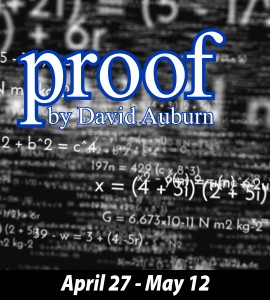Although three of its four characters are mathematicians, you don’t need to know any math to appreciate Proof, but it doesn’t hurt. Nearly all of the math in the play is in the form of “easter eggs” that will gratify anyone who notices them, but none of it is essential to understanding the plot or characters. Proof in 2001 won both the Pulitzer Prize for Drama and the Tony Award for Best Play, neither of which would have been possible if it was primarily about math. There was also a well-regarded but heavily modified film version in 2005 starring Gwyneth Paltrow and Anthony Hopkins.
Proof is a personal favorite of mine, the best and most realistic modern play about real people who do high-level math. David Jepson, artistic director of Renaissance City Theatre, the resident company at the Granite Theatre in Westerly, said, “It was a fear of mine that the topic would be beyond people, but the story speaks so much about relationships and women’s empowerment, and the stereotypes and impressions of where a woman should fit in the world, and that it’s automatically assumed that there’s going to be a level of incompetence there. I think it works well, especially today.”
Some in the theater-going community were put off by the language in the play, particularly “the f-word,” Jepson said, and appreciating the sensitivity he made a point of warning about it in advance. However, radical or subversive plays do not win Pulitzer Prizes and Tony Awards.

In Proof, Robert (David Jepson) is a University of Chicago mathematician of legendary renown who has died after decades of mental illness that prevented him from working. His now-28-year-old student Hal (Nick Perry) says to Robert’s 25-year-old daughter Catherine (Ricci Mann), “When your dad was younger than both of us, he made major contributions to three fields… Most of us never get our heads around one.” Robert’s other daughter Claire (Michelle Mania) flies in from New York City for the funeral.
The cast is uniformly excellent. The central character is Catherine, and Mann excels at the childish-yet-wise persona of a daughter who sacrifices years of her young life caring for a sick father. Robert is a looming presence, seen only in flashback or dream, but Jepson perfectly captures exactly the way I have always imagined the character, exuding charisma and charm despite the vulnerability of illness and old age. (In my view, Jepson is truer to the character than Anthony Hopkins in the film version, who gives a more tragic portrayal in the manner of King Lear.) Perry as Hal is the adoring student whose genuine awe of his teacher transcends the narrow self-interest of which Catherine suspects him. Mania as Claire is very convincing as the only “normal” character who chooses to remain cheerfully ignorant of mathematics, helping with the ordinary activities of life to which Catherine is uncaring and unsuited, such as figuring out what to wear to the funeral.
The play is grounded in the widely believed myth that mathematics is the exclusive province of young men whose most productive years end around age 25. That it has been traditionally male-dominated is certainly true, but no more than nearly all other fields before very recent times. There have been notable female mathematicians throughout history, and Catherine in the play explicitly pays homage to Sophie German as a kind of personal hero: Germain, from about 1800 to her death in 1831, did significant work and carried on correspondence with leading mathematicians of the era, including Joseph-Louis Lagrange and Carl Friedrich Gauss, using a male pseudonym. Eventually both discovered she was female and their reactions were encouraging despite their astonishment, Lagrange taking her on as a student and Gauss unsuccessfully trying to arrange the grant of a doctoral degree to her. Tellingly, Hal has heard of Germain prime numbers – p is a Germain prime if and only if 2p+1 is also prime – but not of their discoverer.
Hal tells Catherine, “There’s this fear that your creativity peaks around 23 and it’s all downhill from there. Once you hit 50 it’s over, you might as well teach high school.” This particular myth was infamously crystallized by G.H. Hardy’s widely read A Mathematician’s Apology, written in 1940 when he was in his early 60s after recently surviving a heart attack. Although much of Hardy’s essay was thoughtful and profound – its most famous lines are, “A mathematician, like a painter or a poet, is a maker of patterns. If his patterns are more permanent than theirs, it is because they are made with ideas.” – his very personal perspective on aging was demonstrably wrong in the general case. Reuben Hersh collected survey responses from 250 older mathematicians a few years ago, reporting that “There are tremendous differences in how mathematicians age. Until we find a consensus about which advances are ‘major,’ we can’t refute Hardy’s claim that no major advance has been made by a mathematician over 50. But his slogan, ‘Mathematics is a young man’s game,’ is misleading, even harmful. So far as it may discourage people from mathematics when they’re no longer young, it’s unjustified and destructive.” Hersh also notes, “J. J. Sylvester pointed out that Leibniz, Newton, Euler, Lagrange, Laplace, Gauss, Plato, Archimedes, and Pythagoras all were productive until their 70s or 80s.”
The play gives a subtle shout-out to Hardy in its first scene, where Catherine admits to her father that she has been depressed for 1,729 weeks, a number today known as the Hardy-Ramanujan number because it was by chance the number on the taxicab that Hardy used to visit his sick student Srinivasa Ramanujan around 1918. Hardy comments that it seems a dull number, but Ramanujan instantly corrects him, saying that it is the smallest number that can be expressed as the sum of two positive cubes in two different ways, a class now called “taxicab numbers” after this story. (Catherine actually gets this wrong in the play, omitting the word “positive,” and relaxing that constraint results in what are called “cabtaxi” numbers.) Ramanujan died at age 33.
Women in mathematics are no longer as rare as they were 200 years ago when Sophie Germain was such an extreme outlier. There are clear parallels between the fictional Catherine and the real-life Emmy Noether whose father was also a mathematics professor (although never mentally ill). Denied admission because she was female to the University of Erlangen where her father taught, Noether studied privately with her father and attended classes anyway; without any undergraduate degree, she passed the examination to enter as a doctoral student, receiving her doctorate summa cum laude in 1908. During World War I, when there was a shortage of professors in Germany, David Hilbert overcame the objections of the University of Göttingen to get her a faculty appointment, saying, “I do not see that the sex of the candidate is an argument against her… After all, the university senate is not a bathhouse.” Even so, Noether was never paid for teaching until the end of her life: as a Jew fleeing Nazi Germany to the United States in 1933, she was hired by women’s college Bryn Mawr on condition that her salary was paid by private charities. By then one of the most well-known mathematicians in the world, she was finally given the title and salary of a full professor at the Institute for Advanced Study in Princeton shortly before her death in 1935.
Proof, written by David Auburn, directed by David Jepson, performed by Renaissance City Theatre at the Granite Theatre, 1 Granite St, Westerly RI. Contains occasional adult language. Thru May 12. Box office: 401-596-2341 Web: granitetheatre.com/productions-new/195-proof
More Posts by The Author:
Heavy Rain, High Winds, Flooding Wed–Thu: Advisory for wind, watches for inland and coastal flooding posted
River Flood Warnings in RI, MA, CT: Wed through Fri, streets may be impassable at times
Snow possible but unlikely Sat mid-day: Little accumulation likely
Snow Thu Night: One inch expected
Significant Snow Storm Tue 5am – 3pm: Likely 6in but remote possibility up to 18in



